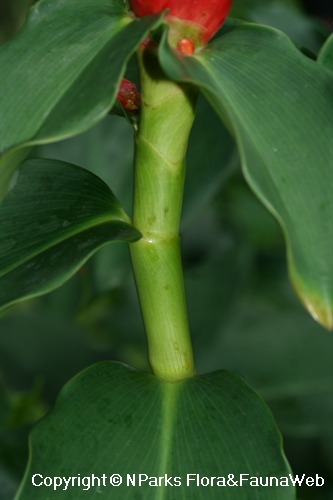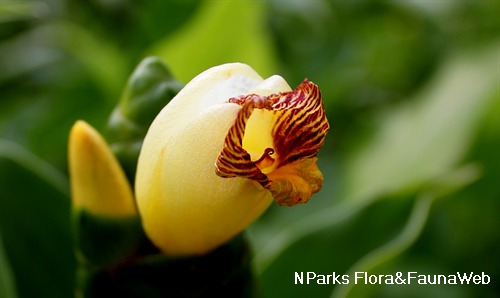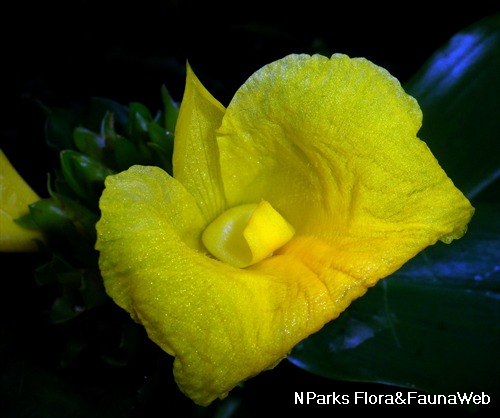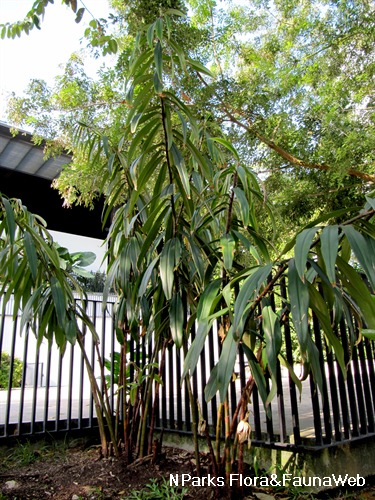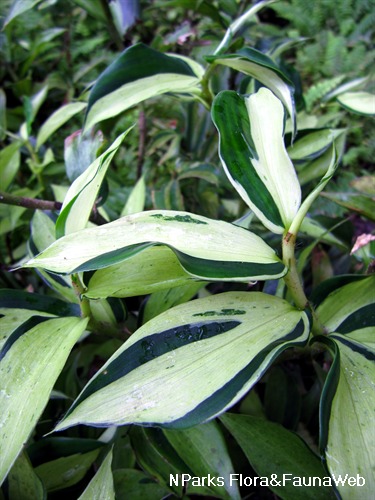
Back
Costus woodsonii Maas
| Family Name: | Costaceae |
| Common Name: | Scarlet Spiral Flag, Red Button Ginger |
Name
Classifications and Characteristics
| Plant Division | Angiosperms (Flowering Seed Plants) (Monocotyledon) |
|---|---|
| Plant Growth Form | Herbaceous Plant |
| Lifespan (in Singapore) | Perennial |
| Mode of Nutrition | Autotrophic |
| Maximum Height | 1 m to 2 m |
| Maximum Plant Spread / Crown Width | 0.6 m to 1 m |
Biogeography
| Native Distribution | Nicaragna to Colombia |
|---|---|
| Native Habitat | Terrestrial (Primary Rainforest, Secondary Rainforest) |
| Preferred Climate Zone | Tropical |
Description and Ethnobotany
| Growth Form | It is a perennial herbaceous plant about 1-2 m tall, with a clump forming growth habit. |
|---|---|
| Foliage | The broadly elliptical leaves (15 cm long, 8 cm wide) are hairless, glossy and spirally arranged along the stems. |
| Stems | Round, succulent stems are produced by an underground horizontal stem known as a rhizome. The aboveground stems are erect to leaning and loosely spiraled. |
| Flowers | The inflorescence is cylindrical with a tapered tip (6-10 cm long) and occurs at the stem tip. The bracts are tightly overlapped, bright red and waxy. The reddish-orange, tubular flowers have a yellow-orange lip near the apex. They emerge at the top of the inflorescence, 1-3 at a time from between the bracts. |
| Fruit | The dry, dehiscent fruit is known as a capsule. It is woody and approximately round to egg-shaped. |
| Associated Fauna | Ants are attracted to the extrafloral nectaries which occur between the bracts and supply nectar. The ants do not pollinate the tubular flowers, but they may help to protect the developing fruits from damage by fly larvae. |
| Cultivation | It grows best in rich, moist soil in semi-shade, being susceptible to sunburn under hot afternoon sun. Feed once a month with a balanced fertilizer such as one with a NPK ratio of 15-15-15. |
| Etymology | The specific epithet 'woodsonii' honours Dr. Robert Woodson Jr. (1904-1963), curator of the Missouri Botanical Garden Herbarium. |
| Ethnobotanical Uses | Edible Plant Parts : Edible Flowers |
Landscaping Features
| Desirable Plant Features | Ornamental Flowers |
|---|---|
| Landscape Uses | General, Parks & Gardens, Small Gardens, Coastal, Flowerbed / Border, Container Planting |
Plant Care and Propagation
| Light Preference | Semi-Shade |
|---|---|
| Water Preference | Occasional Misting, Lots of Water |
| Rootzone Tolerance | Moist Soils, Well-Drained Soils, Saline Soils / Salt Spray, Fertile Loamy Soils |
| Diseases | It is generally resistant to disease. |
| Propagation Method | Stem Cutting (Tip, Herbaceous), Division, Aerial Plantlet |
| Propagation Method Remarks | The stem can be cut into several pieces for propagation. Plantlets form at the base of withered inflorescences. |
Foliar
| Mature Foliage Colour(s) | Green |
|---|---|
| Mature Foliage Texture(s) | Smooth, Glossy / Shiny |
| Prominent Young Flush Colour(s) | Green |
| Young Flush Texture(s) | Smooth |
| Foliar Type | Simple / Unifoliate |
| Foliar Arrangement Along Stem | Spiral |
| Foliar Attachment to Stem | Sessile |
| Foliar Shape(s) | Non-Palm Foliage (Elliptical) |
| Foliar Venation | Parallel |
| Foliar Margin | Entire |
| Foliar Apex - Tip | Acute |
| Leaf Area Index (LAI) for Green Plot Ratio | 3.5 (Shrub & Groundcover - Monocot) |
Floral (Angiosperm)
| Flower Colour(s) | Red, Orange, Yellow / Golden |
|---|---|
| Flower Grouping | Cluster / Inflorescence |
| Flower Location | Terminal |
Fruit, Seed and Spore
| Mature Fruit Colour(s) | White, Red |
|---|---|
| Mature Fruit Texture(s) | Smooth |
| Mature Seed Colour(s) | Black |
Image Repository
Others
| Master ID | 580 |
|---|---|
| Species ID | 1875 |
| Flora Disclaimer | The information in this website has been compiled from reliable sources, such as reference works on medicinal plants. It is not a substitute for medical advice or treatment and NParks does not purport to provide any medical advice. Readers should always consult his/her physician before using or consuming a plant for medicinal purposes. |












